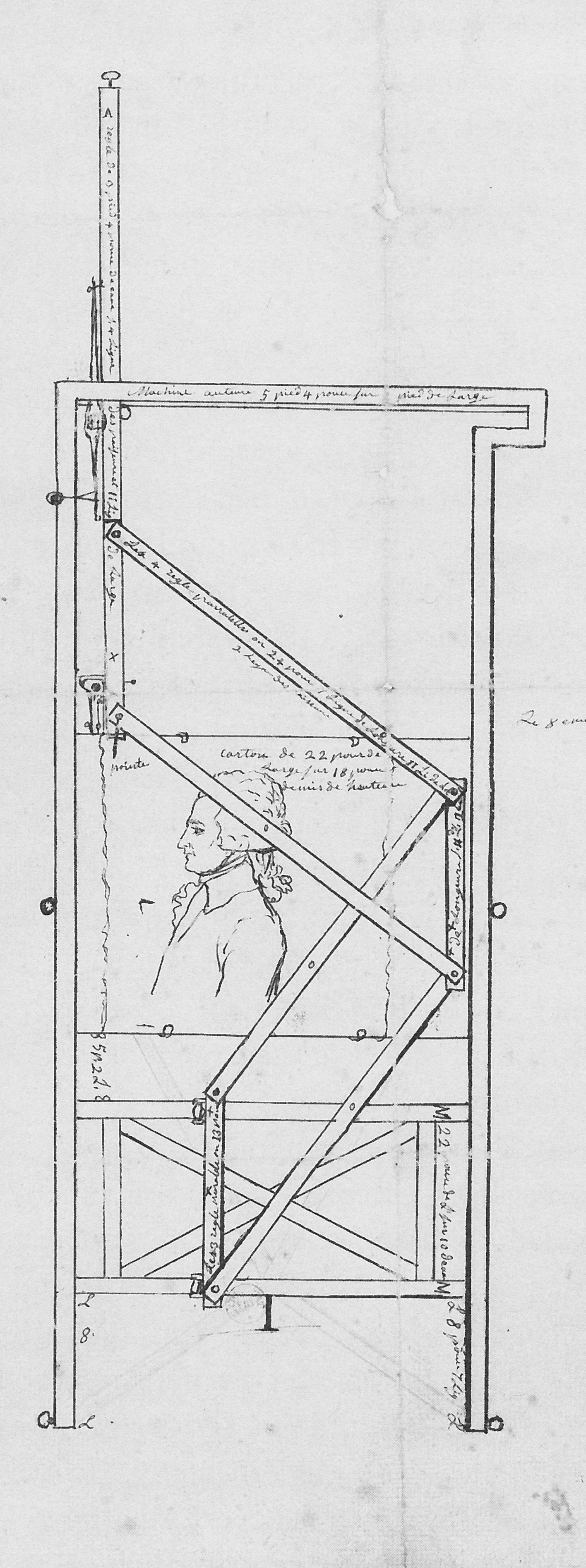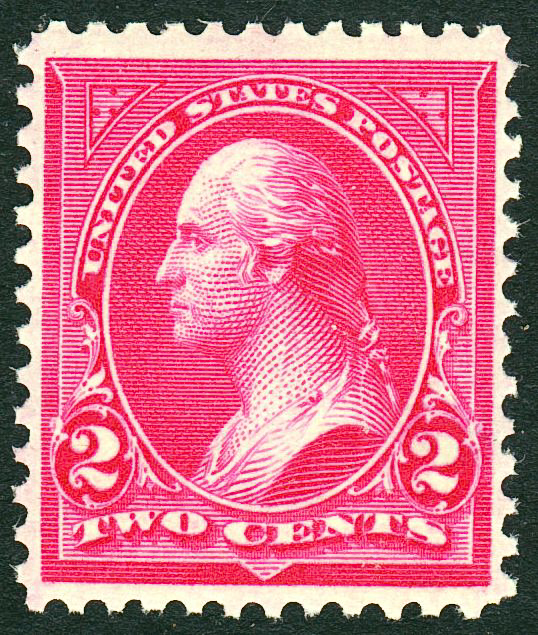|
Physiognotrace
A physiognotrace is an instrument, designed to trace a person's physiognomy to make semi-automated portrait aquatints. Invented in France in 1783–1784, it was popular for some decades. The sitter climbed into a wooden frame (1.75m high x 0.65m wide), sat and turned to the side to pose. A pantograph connected to a pencil produced within a few minutes a "grand trait", a contour line on a piece of paper. With the help of a second scaling-down pantograph, the basic features of the portrait were transferred from the sheet in the form of dotted lines to a copper plate, which had previously been prepared with a ground for etching. One week later, the sitter received an etched plate and twelve little prints. The device but also the aquatint prints are called physionotraces. History In 1783–1784, the Frenchman Gilles-Louis Chrétien invented the "physionotrace" to aid in the production of silhouette portraits, which became popular during the reign of Louis XVI of France, Louis XVI. W ... [...More Info...] [...Related Items...] OR: [Wikipedia] [Google] [Baidu] |
Charles Willson Peale
Charles Willson Peale (April 15, 1741 – February 22, 1827) was an American Painting, painter, soldier, scientist, inventor, politician and naturalist. He is best remembered for his portrait paintings of leading figures of the American Revolution, and for establishing one of the first museums in the United States. Early life Peale was born in 1741 between modern-day Queenstown, Maryland, Queenstown and Centreville, Maryland, Centreville, Queen Anne's County, Maryland, the son of Charles Peale (1709–1750) and his wife Margaret Triggs (1709–1791). He had a younger brother, James Peale (1749–1831). He was the brother-in-law of Nathaniel Ramsey, a delegate to the Congress of the Confederation. Four years after his father’s death in 1750, Charles became an apprentice to a saddle maker by the name of Nathan Waters when he was thirteen years old. Upon reaching maturity, he opened his own saddle shop and joined the Sons of Liberty in 1764 in opposition to the “court” pa ... [...More Info...] [...Related Items...] OR: [Wikipedia] [Google] [Baidu] |
Charles Balthazar Julien Févret De Saint-Mémin
Charles Balthazar Julien Févret de Saint-Mémin (1770–1852) was a French portrait painter and museum director. He left France during the Revolution, and worked as a portrait engraver in the United States in the early 19th century. He created portraits from life of George Washington, Thomas Jefferson, and others. He later served as museum director in Dijon. Brief history Born in France in 1770 to Benigne Charles Fevret and Victoire Marie de Motmans, Saint-Memin was educated at École Militaire, Paris, graduating in 1785. In 1788 he served in the French Guards. During the French Revolution, Saint-Memin and his family travelled to Switzerland, and then in 1793 to New York City. They intended to go to Saint-Domingue, ”to prevent the sequestration of the lands of his creole mother oweverin New York news of the sad fate of that colony made them decide to remain where they were. Faced with earning a living, they first tried raising vegetables, but ... this experiment proved ... [...More Info...] [...Related Items...] OR: [Wikipedia] [Google] [Baidu] |
James Sharples
James Sharples (1751 or 1752, in Lancashire – 26 February 1811, in New York City) was an English portrait painter and pastelist, who moved to the United States in 1794. He first exhibited at the Royal Academy in 1779. Life James was first intended for the Catholic priesthood, but became an artist instead. Sharples headed a family of successful portrait artists, including his third wife Ellen Sharples. He had four children: George by his first wife; Felix Thomas Sharples from his second marriage (c. 1786- after 1823); and James Sharples Jr.(c. 1788–1839) and daughter Rolinda Sharples (1793–1838) with this third wife, Ellen. Felix, James Jr. and Rolinda joined the family enterprise at ages 17, 15, and 13 respectively. Before marrying Ellen Wallace, James had been active in Bristol, Liverpool and Bath, where he taught drawing. The family left for the United States in 1796, but, according to Ellen's diaries, their ship fell into the hands of the French, and for seven m ... [...More Info...] [...Related Items...] OR: [Wikipedia] [Google] [Baidu] |
John Isaac Hawkins
John Isaac Hawkins (1772–1855) was an inventor who practised civil engineering. He was known as the co-inventor of the ever-pointed pencil, an early mechanical pencil, and of the upright piano. Early life Hawkins was born 14 March 1772 at Taunton, Somerset, England,R. L. Tafel, ''Documents Concerning Swedenborg'', p. 1217 the son of Joan Wilmington and her husband Isaac Hawkins, a watchmaker. The father, Isaac Hawkins, would become a Wesleyan minister, but was expelled by John Wesley; and after moving the family to Moorfields in London he was a minister in the Swedenborgian movement, which John Isaac would also follow. John Isaac emigrated to the United States about 1790, attending the College of New Jersey, where he studied medicine and later, chemical filtration. Hawkins married in New Jersey, and was living at Bordentown and Philadelphia. In his own account, he was influenced by work of Georg Moritz Lowitz to try charcoal for filtration purposes, and ran an exhibition on ... [...More Info...] [...Related Items...] OR: [Wikipedia] [Google] [Baidu] |
Pierre Gaveaux By Edmé Quenedey (1821)
Pierre is a masculine given name. It is a French language, French form of the name Peter (given name), Peter. Pierre originally meant "rock" or "stone" in French (derived from the Greek word πέτρος (''petros'') meaning "stone, rock", via Latin "petra"). It is a translation of Aramaic כיפא (''Kefa),'' the nickname Jesus gave to apostle Saint Peter, Simon Bar-Jona, referred in English as Saint Peter. Pierre is also found as a surname. People with the given name * Abbé Pierre, Henri Marie Joseph Grouès (1912–2007), French Catholic priest who founded the Emmaus Movement * Monsieur Pierre, Pierre Jean Philippe Zurcher-Margolle (c. 1890–1963), French ballroom dancer and dance teacher * Pierre (footballer), Lucas Pierre Santos Oliveira (born 1982), Brazilian footballer * Pierre, Baron of Beauvau (c. 1380–1453) * Pierre, Duke of Penthièvre (1845–1919) * Pierre, marquis de Fayet (died 1737), French naval commander and Governor General of Saint-Domingue * Prince Pier ... [...More Info...] [...Related Items...] OR: [Wikipedia] [Google] [Baidu] |



